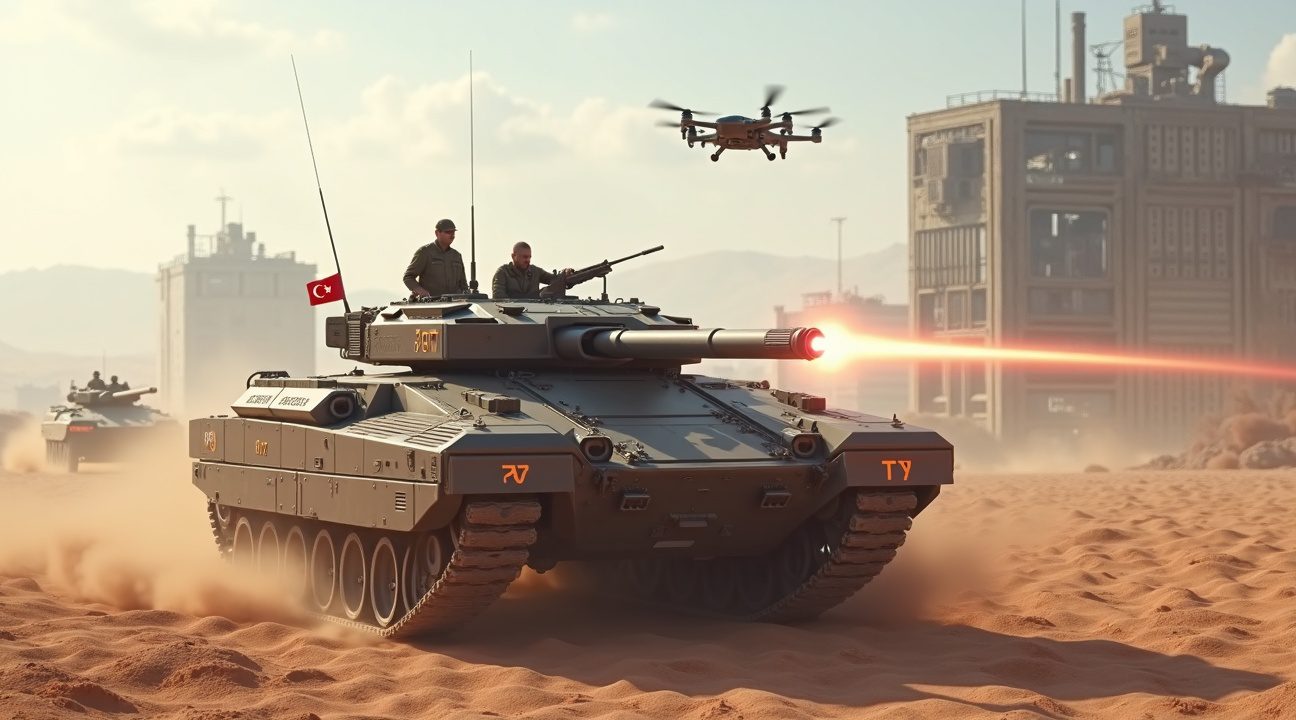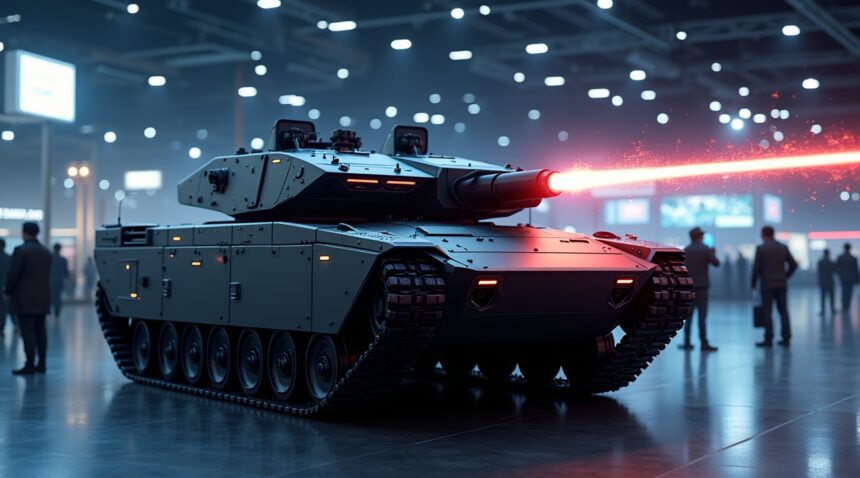Turkey unveiled the ALKA-KAPLAN at IDEF 2025, marking the debut of the world’s first laser-armed tank specifically designed to counter drone threats through a revolutionary combination of electromagnetic jamming and directed energy weapons.
This groundbreaking innovation was the result of a strategic collaboration between FNSS and ROKETSAN. The ALKA-KAPLAN integrates hybrid-electric propulsion with AI-powered targeting systems to present a cost-effective and technologically advanced alternative to traditional missile-based air defense platforms.
Key Takeaways
- Dual-layer defense system combining electromagnetic jamming for soft-kill tactics with high-energy laser weapons capable of hard-kill destruction of drones up to one mile away
- Hybrid electric-diesel propulsion that enables silent movement, extends operational range, and delivers sufficient power for energy-intensive systems, while reducing thermal and noise footprints
- AI-enhanced autonomous features that ensure real-time drone threat detection, classification, and engagement—even without GPS—alongside remote-control operability
- Cost-effective operational model offering significantly reduced per-shot expenditure compared to missile systems, supported by the benefit of virtually unlimited electrical ammunition
- Complete domestic production highlighting Turkey’s self-sufficiency in defense technology, with all components engineered and manufactured locally as a part of its $7.1 billion defense export strategy
ALKA-KAPLAN Delivers World’s First Laser-Armed Tank at IDEF 2025
I witnessed a groundbreaking moment in defense technology at Turkey’s IDEF 2025 defense fair, where the ALKA-KAPLAN system made its debut as the first laser-armed tank specifically engineered to neutralize drone threats at close range. This hybrid-powered armored vehicle represents a significant leap in directed energy weapon integration, combining cutting-edge laser technology with proven tank design principles.
Strategic Partnership Behind the Innovation
The ALKA-KAPLAN system emerged from a strategic collaboration between two Turkish defense giants. FNSS took responsibility for developing the vehicle platform, leveraging their expertise in armored vehicle design to create the foundation for this revolutionary system. ROKETSAN contributed their advanced directed energy weapon capabilities, bringing specialized knowledge in laser technology and precision targeting systems to the partnership.
This collaboration demonstrates how combining complementary expertise can accelerate innovation in defense technology. The partnership allowed each company to focus on their core strengths while creating a unified system that’s greater than the sum of its parts. Such collaborative approaches are becoming increasingly important as defense systems grow more complex and require diverse technical capabilities.
Technical Integration and System Components
The ALKA-KAPLAN builds upon the proven KAPLAN HYBRID chassis, which provides the mobility and protection necessary for modern battlefield operations. This foundation supports the integration of the ALKA Directed Energy Weapon System (DEWS), creating a seamless combination of conventional armored vehicle capabilities with next-generation laser technology.
The hybrid power system serves a dual purpose in this configuration. Beyond providing efficient propulsion for the vehicle, the hybrid drivetrain generates the substantial electrical power required to operate the directed energy weapon system effectively. This integration addresses one of the primary challenges in mobile laser weapon deployment – ensuring adequate power generation without compromising vehicle performance.
Key advantages of this system include:
- Precision targeting capabilities that can engage multiple drone threats rapidly
- Silent operation mode that doesn’t reveal position through muzzle flash or sound
- Virtually unlimited ammunition capacity as long as power remains available
- Reduced logistical burden compared to conventional ammunition-based systems
- Ability to engage targets at various ranges with adjustable power settings
The ALKA-KAPLAN’s debut at IDEF 2025 attracted significant international attention, with defense professionals recognizing the system’s potential to reshape drone defense strategies. The timing of this unveiling coincides with growing global concerns about unmanned aerial vehicle threats across military and civilian applications.
Defense analysts noted that the system addresses a critical gap in current air defense capabilities. Traditional anti-aircraft systems often struggle with small, low-flying drones that can approach undetected and cause significant damage despite their relatively modest size. The ALKA-KAPLAN’s directed energy approach offers precise, cost-effective engagement of such threats without the collateral damage risks associated with explosive munitions.
The system’s hybrid nature also aligns with broader military trends toward more sustainable and efficient platforms. As armed forces worldwide seek to reduce their logistical footprint and operational costs, hybrid-powered vehicles offer compelling advantages. The integration of laser weapons amplifies these benefits by eliminating the need for traditional ammunition resupply chains.
Industry experts suggest that the ALKA-KAPLAN could influence future armored vehicle development significantly. The successful integration of directed energy weapons into a mobile platform demonstrates the feasibility of such systems and may accelerate similar development programs in other countries. This innovation parallels other technological advances we’re seeing across defense sectors, much like developments in autonomous vehicle technology that are reshaping civilian transportation.
The ALKA-KAPLAN represents more than just a new weapon system – it’s a glimpse into the future of armored warfare where energy-based weapons complement traditional kinetic systems. This hybrid approach to both propulsion and weaponry positions Turkey at the forefront of next-generation defense technology development.
Twin-Layered Defense System Combines Jamming and Laser Destruction
The ALKA-KAPLAN represents a breakthrough in military defense technology through its innovative dual-approach system. This twin-layered architecture is particularly impressive because it addresses the complete spectrum of aerial threats with both finesse and raw power.
Soft-Kill Capabilities Through Electromagnetic Warfare
The system’s soft-kill component employs sophisticated electromagnetic jamming technology that disrupts the very foundations of drone operation. This approach targets the communication links and guidance systems that drones depend on for navigation and control. Rather than physically destroying targets, electromagnetic jamming creates an invisible barrier that renders micro- and mini-UAVs ineffective by severing their connections to operators or GPS satellites.
Loitering munitions face similar vulnerabilities when confronted with this electromagnetic assault. The beauty of soft-kill methods lies in their ability to neutralize threats without creating debris fields or collateral damage. This makes the technology particularly valuable in urban environments where autonomous systems must operate with precision.
Hard-Kill Laser System Delivers Precise Destruction
The hard-kill component showcases the true power of directed energy weapons through its high-energy laser system. This technology can detect, track, and destroy aerial threats at distances reaching one mile, providing substantial defensive coverage. The laser’s effectiveness stems from its ability to deliver concentrated energy that physically damages or destroys incoming threats.
The target range extends far beyond traditional drones to include:
- Fixed-wing and rotary drones of various sizes
- Loitering munitions designed for extended flight times
- Improvised explosive devices (IEDs) that pose ground-based threats
- Landmines requiring safe disposal
- Unexploded ordnance in conflict zones
The versatility of targets demonstrates how advanced robotics can adapt to multiple mission requirements. Each engagement happens with surgical precision, eliminating the risk of unintended consequences that traditional explosive countermeasures might create.
Artificial Intelligence integration elevates the entire system beyond conventional defense platforms. The AI-powered detection capabilities enable real-time threat assessment and prioritization, ensuring that the most dangerous targets receive immediate attention. This intelligent approach becomes crucial during coordinated drone swarm attacks, where dozens of small UAVs might attempt to overwhelm traditional defense systems.
The AI component continuously analyzes incoming threats, determining whether soft-kill jamming or hard-kill laser engagement provides the optimal response. This decision-making process happens in milliseconds, far faster than human operators could manage. During swarm scenarios, the system can simultaneously track multiple targets while coordinating both jamming and laser responses to maximize defensive effectiveness.
Turkey’s development of this technology positions the nation at the forefront of smart technology integration in defense applications. The ALKA-KAPLAN’s twin-layered approach addresses a critical gap in modern warfare, where traditional kinetic weapons often prove inadequate against small, agile aerial threats.
The electromagnetic jamming system operates continuously, creating a protective bubble that prevents unauthorized drones from establishing stable communication or navigation. Meanwhile, the laser system remains ready for immediate deployment against hardened targets that resist jamming attempts. This combination ensures comprehensive protection against the evolving landscape of aerial threats that military forces face today.
Future warfare scenarios will likely feature increased reliance on unmanned systems, making technologies like the ALKA-KAPLAN essential for maintaining tactical advantages. The system’s ability to engage multiple threat types with appropriate responses demonstrates how cutting-edge technology can revolutionize defense strategies while minimizing risks to friendly forces and civilian populations.

Hybrid Propulsion Delivers Silent Operations and Extended Range
The ALKA-KAPLAN’s domestically-developed hybrid electric-diesel powertrain represents a significant advancement in military vehicle technology. This innovative system provides operators with the critical advantage of silent operations during sensitive missions while maintaining the power and reliability needed for extended field deployments.
Enhanced Stealth Capabilities Through Reduced Signatures
The hybrid propulsion system dramatically reduces both acoustic and thermal signatures compared to traditional diesel-only platforms. By operating in electric-only mode during crucial phases, the vehicle can approach target areas without the typical engine noise that alerts enemy forces or drone operators. The reduced thermal signature also makes the platform less detectable by infrared sensors, creating multiple layers of stealth protection.
Silent Watch mode enables extended surveillance operations without revealing the vehicle’s position. Engineers achieved a reported 10% increase in idle range while delivering significant noise reduction that transforms tactical positioning capabilities. This extended operational endurance proves essential for counter-drone missions that require patience and persistence.
The platform’s impressive 20-ton capacity accommodates various defensive systems while maintaining mobility across diverse terrain. This substantial payload capability allows military forces to deploy comprehensive smart systems alongside the primary laser weaponry without compromising vehicle performance.
Modular design features distinguish the ALKA-KAPLAN from conventional military vehicles. The adaptable architecture supports future tracked vehicle programs and system upgrades without requiring complete platform redesigns. This flexibility ensures long-term operational relevance as drone technology continues advancing and new threats emerge.
Full integration of onboard systems enables both remote-controlled and autonomous operations, expanding tactical options for commanders. Mission cameras provide real-time battlefield awareness while specialized kits enhance operational capabilities across various scenarios. The image-based navigation systems allow precise positioning even in GPS-denied environments.
Remote operation capabilities prove particularly valuable for counter-drone missions in high-risk areas. Operators can position the vehicle strategically while maintaining safe distances from potential threats. The autonomous features also enable coordinated operations with other military assets, creating layered defense networks against drone swarms.
The electric propulsion component provides instant torque delivery, enabling rapid repositioning during engagements. This immediate response capability proves crucial against fast-moving aerial targets that require quick defensive reactions. The seamless transition between electric and diesel modes ensures continuous operation regardless of mission demands.
Extended range capabilities transform operational planning by reducing logistical requirements. Units can deploy the ALKA-KAPLAN for longer periods without fuel resupply, increasing mission flexibility and reducing support convoy risks. This enhanced endurance particularly benefits border security operations and forward deployment scenarios.
The hybrid system’s regenerative capabilities recover energy during deceleration and downhill movement, further extending operational range. This energy recovery feature reduces overall fuel consumption while maintaining peak performance during critical engagement periods. Such efficiency improvements directly translate to increased mission success rates and reduced operational costs.
Integration with future tracked vehicle programs demonstrates Turkey’s commitment to developing scalable defense technologies. The platform’s proven hybrid architecture can adapt to various military applications, from advanced mobility solutions to specialized support vehicles.
Environmental conditions rarely impact the hybrid system’s performance, ensuring reliable operation across diverse climates and terrains. The dual-power approach provides redundancy that maintains mission capability even if one propulsion system experiences issues. This reliability proves essential for critical defense operations where equipment failure isn’t acceptable.
The ALKA-KAPLAN’s propulsion innovations establish new standards for modern military vehicles while providing immediate tactical advantages against evolving drone threats. Its combination of stealth, endurance, and adaptability positions this platform as a cornerstone technology for future defense strategies.

Cost-Effective Alternative Transforms Battlefield Defense
ALKA-KAPLAN represents a groundbreaking shift in military economics, delivering laser and electromagnetic countermeasures at a fraction of traditional missile defense costs. Unlike conventional systems that drain defense budgets with each expensive missile launch, this innovative platform operates on a cost-per-use model that significantly reduces operational expenses while maintaining superior defensive capabilities.
Multi-Layered Defense Architecture
The system’s dual-layer approach combines soft-kill and hard-kill mechanisms to create a comprehensive defensive shield. Traditional air defense platforms rely heavily on missile-only solutions, which limit engagement options and drain resources quickly. ALKA-KAPLAN’s electromagnetic jamming capabilities can neutralize incoming threats without physical destruction, while its laser systems provide precise hard-kill options for situations requiring immediate threat elimination.
Classified as a modular, multi-role armored vehicle rather than a conventional tank, ALKA-KAPLAN integrates seamlessly with existing ground forces. Military units can deploy this system alongside tanks and infantry formations, providing near-range aerial protection in contested environments where traditional air defense systems might prove inadequate or too expensive to maintain.
Advanced Technology Integration
ALKA-KAPLAN’s hybrid-powered design delivers several operational advantages over fuel-intensive and noisy traditional platforms. The low-signature mobility system reduces detection risks while extending operational endurance, making it particularly valuable in forward deployment scenarios where fuel resupply becomes challenging.
The platform’s AI-driven swarm targeting capabilities represent a significant advancement over manual or radar-only guidance systems. Modern warfare increasingly features coordinated drone attacks that can overwhelm traditional defenses, but ALKA-KAPLAN’s intelligent targeting algorithms can simultaneously engage multiple threats with precision accuracy.
Key operational advantages include:
- Cost-effective per-use rates compared to high-cost missile launches
- Dual-layer defensive capabilities providing flexible response options
- Hybrid power systems reducing logistical support requirements
- AI-enhanced targeting for complex multi-threat scenarios
- Modular design allowing rapid deployment with existing forces
The economic implications extend beyond initial procurement costs. Traditional missile defense systems require constant ammunition replenishment, with each interceptor missile costing tens of thousands of dollars. ALKA-KAPLAN’s laser systems operate on electrical power, dramatically reducing per-engagement expenses while maintaining unlimited ready-to-fire capacity.
This technological advancement parallels other innovations in defense technology, similar to how autonomous systems have transformed civilian transportation. The integration of AI and advanced sensors creates defensive capabilities that adapt to evolving threats without requiring complete system replacements.
Military planners increasingly recognize that drone warfare represents the future of conflict, making systems like ALKA-KAPLAN essential for maintaining tactical superiority. The platform’s ability to neutralize both individual threats and coordinated swarm attacks provides commanders with flexible defensive options previously unavailable through conventional systems.
The scalable nature of ALKA-KAPLAN’s technology allows military forces to adjust defensive capabilities based on specific mission requirements. Units can configure the system for different threat levels, from small reconnaissance drones to larger armed platforms, without requiring specialized ammunition or complex targeting solutions.
Future battlefield scenarios will likely feature increased reliance on unmanned systems, making cost-effective counter-drone capabilities crucial for military success. ALKA-KAPLAN’s innovative approach demonstrates how advanced technology can reduce operational costs while improving defensive effectiveness, setting new standards for next-generation military platforms.
Turkey’s Defense Self-Sufficiency Drives Innovation
Turkey’s commitment to domestic defense production reaches new heights with the ALKA-KAPLAN laser tank, where every critical component emerges from Turkish manufacturing facilities. I observe how the powerpack and cross-drive gearbox represent entirely indigenous designs, showcasing the nation’s growing technological capabilities in high-precision military hardware.
The timing of this laser tank deployment reflects Turkey’s accelerating defense industry expansion. Export figures reveal remarkable growth, with arms sales reaching $7.1 billion in 2024 compared to just $1.9 billion a decade earlier — representing a substantial 65% year-on-year increase. This dramatic surge positions Turkey among the world’s fastest-growing defense exporters.
Strategic Independence Through Local Production
Turkey’s defense strategy centers on eliminating foreign dependencies for critical military technologies. The ALKA-KAPLAN program exemplifies this approach, as engineers develop every major subsystem within Turkish borders. This comprehensive domestic production capability reduces supply chain vulnerabilities while creating valuable intellectual property assets.
The broader implications extend beyond individual weapons systems. Turkey’s defense sector now produces:
- Advanced targeting systems and optical equipment
- Sophisticated electronic warfare components
- High-performance vehicle platforms and armor solutions
- Cutting-edge laser technology and power management systems
- Precision manufacturing tools for military applications
This self-reliant approach generates significant economic benefits while strengthening national security. Turkish defense companies can now compete internationally without relying on foreign technology transfers or component imports. The strategy also creates opportunities for technology spillover into civilian sectors, similar to how flying car development benefits from aerospace innovations.
Export market expansion represents another crucial element of Turkey’s defense evolution. The country actively pursues partnerships with nations seeking reliable alternatives to traditional defense suppliers. Turkish manufacturers offer competitive pricing combined with flexible technology transfer agreements, making their products attractive to emerging markets.
The laser tank program demonstrates Turkey’s ability to innovate in specialized defense niches. Few countries possess the technical expertise to develop effective anti-drone laser systems, yet Turkish engineers successfully integrated multiple complex technologies into a mobile platform. This achievement rivals developments in other high-tech fields, including advanced robotics and autonomous vehicle systems.
Manufacturing capabilities continue expanding as Turkish defense companies invest heavily in research facilities and production infrastructure. The government supports these efforts through favorable policies and strategic funding allocations. Private sector participation accelerates innovation cycles while maintaining quality standards essential for military applications.
International recognition of Turkish defense products grows steadily, with several NATO allies expressing interest in laser-based anti-drone systems. The ALKA-KAPLAN’s proven performance opens doors for future collaborations and joint development programs. This success parallels other ambitious technological projects, such as NASA’s innovative propulsion research and commercial space initiatives.
Turkey’s defense transformation reflects broader technological ambitions across multiple sectors. The same engineering expertise driving laser tank development contributes to innovations in telecommunications, automotive manufacturing, and aerospace applications. This cross-pollination effect strengthens the entire industrial base while creating new export opportunities.
The shift from defense imports to exports marks a fundamental change in Turkey’s strategic position. Previously dependent on foreign suppliers for advanced military systems, the country now develops cutting-edge technologies that compete globally. This transformation took years of sustained investment in education, research infrastructure, and manufacturing capabilities.
Recent technological advances extend beyond traditional defense applications, incorporating elements found in smart glasses technology and other consumer electronics. The convergence of military and civilian technologies creates synergies that benefit both sectors while accelerating innovation cycles throughout Turkish industry.

Integrated Technologies Enable Advanced Autonomous Operations
The ALKA-KAPLAN represents a sophisticated fusion of multiple advanced systems that work together to create an unprecedented anti-drone defense platform. At its core, the hybrid electric-diesel drivetrain provides the vehicle with enhanced operational endurance while reducing thermal signatures that could compromise stealth capabilities. This power system directly supports the energy-intensive requirements of the onboard laser systems and electronic warfare equipment.
FNSS and ROKETSAN have integrated the ALKA Directed Energy Weapon System as the platform’s primary engagement tool, delivering precision strikes against aerial targets without requiring traditional ammunition. The high-energy laser emitter can neutralize drones through thermal damage while the electromagnetic jamming suite disrupts communication links and navigation systems before threats reach engagement range. These complementary systems create multiple layers of defense that can adapt to different threat scenarios in real-time.
AI-Powered Detection and Autonomous Capabilities
The platform’s AI-assisted tracking system continuously monitors airspace using advanced sensor arrays that can identify and classify aerial threats automatically. This intelligent detection network processes visual, thermal, and electronic signatures to distinguish between hostile drones and friendly aircraft. The system maintains tracking locks even when targets attempt evasive maneuvers or deploy countermeasures.
Mission payloads can be customized based on operational requirements, allowing commanders to configure the ALKA-KAPLAN for specific threat environments. Image-assisted navigation enables the vehicle to operate effectively in complex terrain while maintaining situational awareness. Most importantly, the GPS-denied operational capability ensures continued functionality even when satellite navigation is compromised by enemy jamming or in contested electromagnetic environments.
Remote-controlled operation allows operators to engage threats from safe distances, while autonomous modes enable the system to function independently during extended missions. The integration of these technologies mirrors advances seen in other autonomous systems, similar to developments in self-driving cars that rely on AI for navigation and decision-making.
The ALKA-KAPLAN’s technological integration extends beyond individual components to create a synergistic defense ecosystem. The electromagnetic jamming suite can disable drone swarms while the laser system eliminates individual high-value targets with surgical precision. This dual-capability approach addresses the evolving nature of aerial threats, from single reconnaissance drones to coordinated attack formations.
Advanced sensor fusion combines data from multiple sources to create comprehensive threat pictures that inform engagement decisions. The system processes information faster than human operators could manage, enabling rapid response times critical for intercepting fast-moving targets. Machine learning algorithms continuously improve threat recognition accuracy based on operational experience.
The platform’s design philosophy prioritizes adaptability and scalability, allowing for future technology integration as threats evolve. Energy management systems optimize power distribution between mobility, sensors, and weapons systems based on tactical requirements. Communication systems maintain connectivity with command networks while operating in electromagnetic-contested environments.
Turkish defense innovation has positioned the ALKA-KAPLAN as a game-changing technology that addresses modern warfare’s most pressing challenges. The system’s debut at IDEF 2025 demonstrates Turkey’s growing capabilities in advanced military technology development. The integration of hybrid armored vehicle design with directed energy weapons represents a significant leap forward in ground-based air defense capabilities.
This technological convergence creates opportunities for enhanced battlefield effectiveness while reducing logistical burdens associated with traditional ammunition-based systems. The ALKA-KAPLAN’s modular design allows for rapid deployment and reconfiguration based on mission requirements, making it suitable for both defensive positions and mobile operations across diverse operational theaters.
Sources:
Eurasian Times – World’s 1st Laser Tank Designed to Fight Kamikaze Drones: Meet Turkey’s ALKA-KAPLAN – The Game-Changing Tank
The Defense Post – Turkey Unveils Laser-Armed Tank for Drone Defense
SAN News – Turkey Unveils Laser-Armed Anti-Drone Armored Vehicle
NextGen Defense – Turkey Unleashes Laser-Armed Tank That Can Fry and Jam Drones
GlobalSpec – New Laser Tank Disables and Destroys Drones in Mid-Air


